
Echinacea is a genus, or group of herbaceous flowering plants in the daisy family. The genus Echinacea has ten species, which are commonly called coneflowers. They are found only in eastern and central North America, where they grow in moist to dry prairies and open wooded areas. They have large, showy heads of composite flowers, blooming the entire summer. The generic name is derived from the Greek word ἐχῖνος, meaning "sea urchin", due to the spiny central disk. These flowering plants and their parts have different uses. Some species are cultivated in gardens for their showy flowers. Echinacea purpurea is used in traditional medicine. Two of the species, E. tennesseensis and E. laevigata, are listed in the United States as endangered species.

Claytonia perfoliata, also known as miner's lettuce, Indian lettuce, spring beauty, or winter purslane, is a flowering plant in the family Montiaceae. It is a fleshy, herbaceous, annual plant native to the western mountain and coastal regions of North America, from southernmost Alaska and central British Columbia, all the way south to Central America, but most common in California in the Sacramento and northern San Joaquin Valleys.

Claytonia virginica, the Virginia springbeauty, eastern spring beauty, grass-flower or fairy spud, is an herbaceous perennial in the family Montiaceae. Its native range is eastern North America. Its scientific name honors Colonial Virginia botanist John Clayton (1694–1773).

Claytonia is a genus of flowering plants native to North America, Central America, and Asia. The genus was formerly included in Portulacaceae but is now classified in the family Montiaceae, primarily native to the mountain chains of Asia and North America, with a couple of species extending south to Guatemala in Central America, and northwest to Kazakhstan, Mongolia, and Russia in eastern Asia.

Claytonia sibirica is a flowering plant in the family Montiaceae, native to the Commander Islands of Siberia, and western North America from the Aleutian Islands and coastal Alaska south through the Queen Charlotte Islands, Vancouver Island, Cascade and Coast Ranges, to a southern limit in the Santa Cruz Mountains. Populations are also known from the Wallowa Mountains, Klamath Mountains, northern Idaho, and The Kootenai. A synonym is Montia sibirica. The plant was introduced into the United Kingdom by the 18th century, where it has become very widespread.
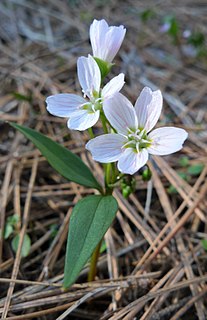
Claytonia lanceolata is a species of wildflower in the family Montiaceae, known by the common names lanceleaf springbeauty and western springbeauty.

Claytonia exigua is a species of wildflower known by the common names serpentine springbeauty and pale claytonia, in the family Montiaceae.

Chaenactis stevioides, with the common names Esteve's pincushion and desert pincushion, is a species of flowering plant in the daisy family.
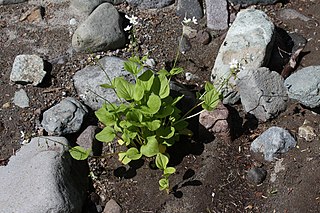
Claytonia cordifolia is a species of wildflower in the family Montiaceae known by the common name heartleaf springbeauty. It is native to western North America from British Columbia to Utah, where it grows in shallow lakes and in streams or springs and wetlands including bogs and fens according to Miller and Chambers (2006). It is a perennial herb growing from a long, budding rhizome and producing an erect stem up to 40 centimeters tall. The basal leaves have oval blades up to 9 centimeters long with heart-shaped bases where they attach to their long petioles. There is also a pair of oval-shaped leaves at a midpoint on the stem. The stalked inflorescence bears up to 12 small flowers with five white petals each about a centimeter long.
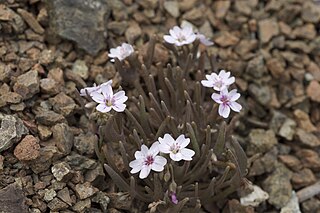
Claytonia gypsophiloides, known by the common names gypsum springbeauty and Coast Range claytonia, is a species of wildflower in the family Montiaceae.

Claytonia megarhiza is a species of wildflower in the family Montiaceae known by the common names fell-fields claytonia and alpine springbeauty. It is native to western North America from northwestern Canada to New Mexico, where it grows in rock crevices and talus habitats in subalpine and alpine climates. The species is known from summits and slopes of North America's highest mountains including the Redstone Mountains of the Canadian Northwest Territories, disjunct south to the central and southern Rocky Mountains reaching a southern limit in the Sangre de Cristo Mountains. The specific epithet megarhiza is Greek for "large roots".
Claytonia nevadensis, known by the common names Sierra springbeauty and Sierra Nevada claytonia, is a species of wildflower in the family Montiaceae. The evolutionary relationship of Claytonia nevadensis to other claytonias is a subject of debate and ongoing genetic studies. Sierra springbeauties are diploid with a chromosome base number of x = 7
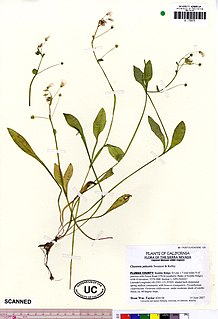
Claytonia palustris is a species of wildflower in the family Montiaceae known by the common names Jonesville springbeauty and marsh claytonia.
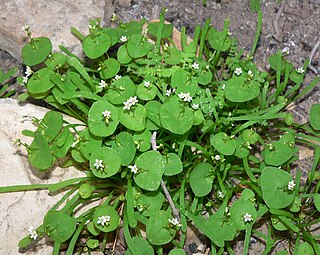
Claytonia parviflora is a species of wildflower in the family Montiaceae known by the common name Indian lettuce. It is native to western North America from southwestern Canada to northwestern Mexico, where it is found in many types of habitat, particularly areas that are moist in the spring. This is an annual herb growing in a clump or spreading to a maximum length of about 30 centimeters. The basal leaves are linear, often with an indistinct petiole. Some races may have lance-shaped blades on long, tapering petioles. There are also leaves on the flower stem which may be similar in shape or may be rounded or squared and sometimes fuse together to create a bowl around the stem. The herbage is green to pink in color. The inflorescence is a cluster of up to 40 small flowers, each with petals a few millimeters long and white to pink-tinted, or deep pink in color. The largest flowers, up to 1 cm in diameter, are found in Claytonia parviflora subsp. grandiflora, which is a subspecies endemic to the foothills and lower slopes of the western Sierra Nevada of North America. Together with Claytonia perfoliata and Claytonia rubra, Claytonia parviflora comprises what is almost certainly a polyploid pillar complex
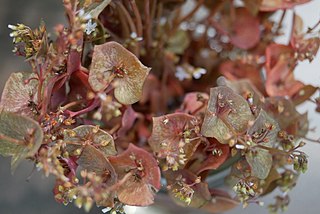
Claytonia rubra is a species of wildflower in the family Montiaceae known by the common names redstem springbeauty and erubescent miner's lettuce. It is native to western North America from southwestern Canada to the Transverse Range of California, U. S. A. (and east to the Black Hills of South Dakota, U. S. A., where it is found in coniferous forests and shrublands. This is an annual herb with stems up to about 15 centimeters long. Some individuals may overwinter as biennials. The basal leaves have small rounded to diamond-shaped blades on long, tapering petioles. There are also leaves on the stem which may be rounded or squared and sometimes fuse together to create a bowl around the stem. All the leaves possess blunt tips according to published descriptions and taxonomic treatments. The herbage is red or pink in color at all stages of development. The inflorescence is a dense cluster of up to 30 tiny flowers, each with petals less than 4 millimeters long and white to pink-tinted in color. Together with Claytonia perfoliata and Claytonia parviflora, Claytonia rubra comprises what is almost certainly a polyploid pillar complex based on three diploid species, each occupying a definitive ecological niche
Claytonia saxosa, known by the common name Brandegee's springbeauty, is a species of wildflower in the family Montiaceae.

Claytonia caroliniana, the Carolina springbeauty, is an herbaceous perennial in the family Montiaceae. It was formerly placed in the Portulacaceae. Its native range is eastern and central North America. It is most commonly found in the New England area of the United States but its habitat extends from Ontario and a northern limit in the Cape Anguille Mountains of Newfoundland and south to Alabama. It grows approximately 6 inches tall in forests of the Appalachian Mountains and piedmont
Claytonia tuberosa, commonly known as Beringian springbeauty, is a species of flowering plant in the family Montiaceae. It is a perennial herb indigenous to Alaska, British Columbia, Northwest Territories, and the Yukon of North America, westward to East Asia–Siberia. The perennial grows from a globose tuberous root to a height of 15 centimetres (6 in) and bears several hermaphrodite white flowers on stems bearing a single pair of petiolate cauline leaves. Probably its closest relative is Claytonia virginica.
Claytonia ogilviensis, common name Ogilvie Mountains spring beauty, is a plant endemic to the Ogilvie Mountains north of Dawson City in the Yukon Territory of Canada. These mountains extend into Alaska, and one of the known populations is less than 1 km from the border, so it would not be surprising if the plant were to be found in Alaska as well.

Claytonia rosea, the Madrean springbeauty, is a diminutive perennial herb with long-lived, globose tuberous roots, reddish to green, long-tapered basal leaves, petiolate, cauline leaves, and light pink to magenta flowers. It is found in dry meadows in forests of ponderosa and Chihuahuan pines, and moist ledges of mountain slopes of the Beaver Dam Mountains of Utah, Colorado Front Range, and Sierra Madre Occidental, south and east to the Sierra Maderas del Carmen of Coahuila.














